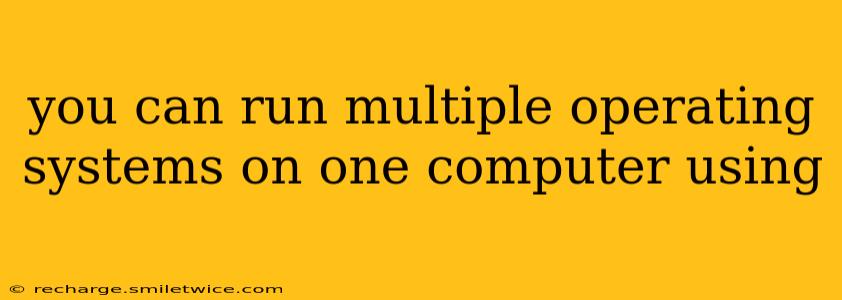Run Multiple Operating Systems on One Computer Using Virtual Machines and Dual Booting
Want to run multiple operating systems on a single computer? You're in luck! There are several ways to achieve this, each with its own advantages and disadvantages. The two most popular methods are using virtual machines (VMs) and dual booting. Let's explore both.
What is a Virtual Machine (VM)?
A virtual machine is a software emulation of a physical computer. It creates a virtual environment within your existing operating system, allowing you to install and run another operating system, or even multiple operating systems, simultaneously. Think of it as having several computers all running within a single computer.
Advantages of using VMs:
- Simultaneous operation: You can switch between operating systems instantly without restarting your computer.
- Isolation: Each VM is isolated from the others, preventing software conflicts and keeping your main OS safe.
- Easy setup and management: Software like VMware Workstation Player, VirtualBox, and Hyper-V provide user-friendly interfaces to create, manage, and delete VMs.
- Resource allocation: You can allocate specific resources (RAM, CPU cores, hard drive space) to each VM, optimizing performance based on your needs.
Disadvantages of using VMs:
- Performance overhead: VMs require resources from your host operating system, potentially impacting its performance, especially if you're running multiple resource-intensive VMs.
- Limited performance: VMs will generally not perform as well as a native installation of the operating system.
- Software limitations: Certain software might not work correctly or be compatible with a virtualized environment.
What is Dual Booting?
Dual booting allows you to install multiple operating systems on your computer's hard drive. When you start your computer, you're presented with a boot menu that lets you choose which operating system to load.
Advantages of Dual Booting:
- Better performance: Each operating system runs natively, resulting in optimal performance.
- Full access to hardware: Operating systems have complete access to the computer's hardware, without virtualization overhead.
- Compatible with more software: Compatibility issues are less common compared to VMs.
Disadvantages of Dual Booting:
- Restart required: Switching between operating systems requires a restart.
- Data Partitioning: Requires careful planning and partitioning of your hard drive to allocate space for each operating system.
- Risk of data loss: Incorrect partitioning can lead to data loss. This method requires more technical expertise than using virtual machines.
How to Choose Between VMs and Dual Booting?
The best choice depends on your needs and technical skills.
-
Choose Virtual Machines if: You need to run multiple operating systems simultaneously, require isolation between them, and prioritize ease of setup and management. You also have sufficient resources on your main computer and are not running resource-intensive apps within those VMs.
-
Choose Dual Booting if: You need optimal performance for each operating system and are comfortable with the technical aspects of partitioning a hard drive. You will primarily use one OS at a time.
What are the common operating systems used for dual booting or virtual machines?
Many operating systems are compatible with both methods. Popular choices include Windows, macOS, Linux (various distributions like Ubuntu, Fedora, Mint), and ChromeOS.
Can I run multiple operating systems at the same time?
Yes, you can run multiple operating systems simultaneously using virtual machines. However, dual booting requires restarting your computer to switch between operating systems.
Which method is easier to set up?
Generally, setting up virtual machines is easier than dual booting, especially for users with limited technical experience. Dual booting requires more technical understanding of disk partitioning and bootloader configurations.
This detailed explanation should give you a comprehensive understanding of how to run multiple operating systems, and help you choose the best method for your needs! Remember to back up your data before making any significant changes to your computer's operating system configuration.
